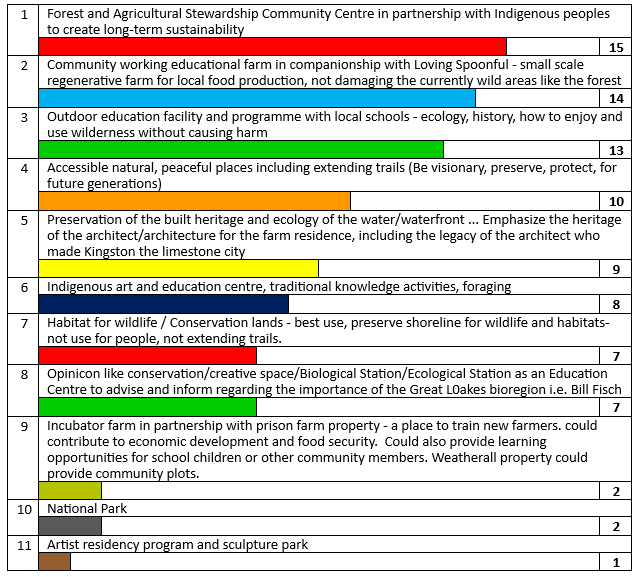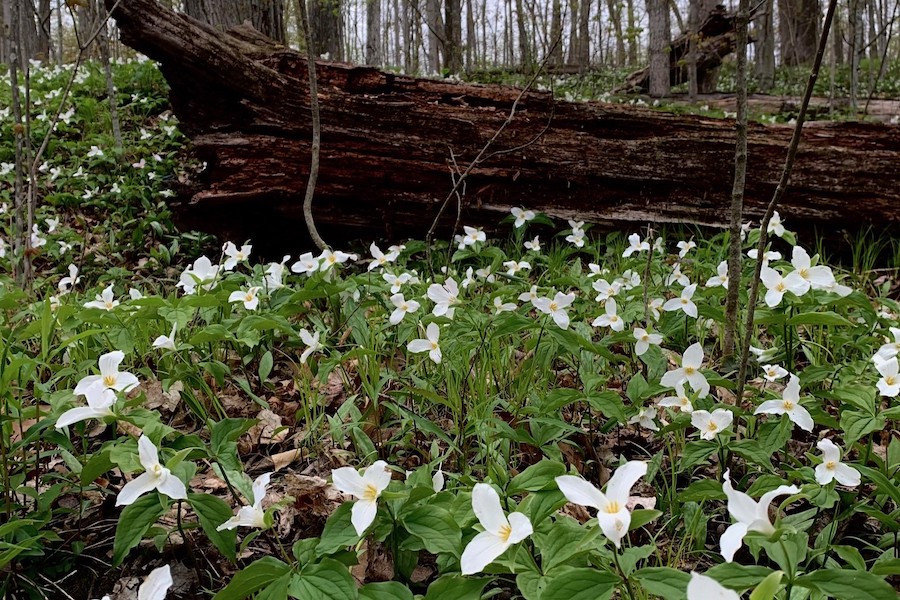
Report on the Community Meeting held at Centre 70, January 9, 2024
Organized by the Save Lemoine Point Farm group
- Agriculture. Sustainable farming. Regenerative farming. Local food production. Training farmers. Community Garden.
- Conservation: Habitat for wildlife. No trails. Maintain forest. Peaceful place. Protect for future generations.
- Education: To learn ecology, history, where food comes from, how to enjoy the wilderness without causing harm, importance of Great Lakes. Outdoor Centre.
- Heritage: Preserve the houses and recognize their architect.
- Indigenous: Traditional knowledge. Leadership. Indigenous art and education centre.
- Other: National Park. Artist residency program. Sculpture park. Access to the waterfront. Waterfront trail. Examples of models from other places.
Erik then asked each table to submit their two top ideas. He discussed the list of top twenty ideas (a few tables submitted more than two) and amalgamated, with participant input, ideas that were similar. The result was a list of 11 ideas. Each table then divided into two and each sub-group ranked their top five of these 11 ideas, abstentions allowed. Here are the results with the ranking shown on the right:

Other ideas
Ideas drop off through this process when they don’t make the top two ideas submitted by a table. Here are some of these other ideas:
Animal rescue. Farm sanctuary. Studio space for artists. Nature retreat. Concert venue. Camping for youth. Archaeological activities. Seed saving sanctuary. Rowing club. Scuba diving. Green burials/place to scatter ashes. Shared community space with free access for all. Rental space for workshops, special events. Partner with St. Lawrence College, Queen’s University, Conservation Authority. Expand bus service. Link to nearby Weatherall property which is owned by the City. Create a natural heritage corridor connecting to Mile Square. Have land trust purchase the land. Repatriate the land for All Our Relations Land Trust, a new local Indigenous land trust.
Places referenced by participants as good models to consider
Bill Fisch Forest Stewardship and Education Centre, Whitchurch-Stouffville. Queen’s University Biology Station at Lake Opinicon. Shelburne Farms, Vermont. Stowe, England. Upper Canada Village.
What participants don’t want
After a short discussion, participants noted the following potential misuses of the Farm: residential development, McMansions, commercial or manufacturing, extension of the airport, ATVs, snowmobiles, motorcycles, parking lot, golf course, marina, new trails, for-profit activity, cemetery, cutting down of the forest, anything that would destroy biodiversity.
Thank you to the participants who came out on a stormy, miserable January evening because they care about the future of Lemoine Point Farm. Thank you to Erik Lockhart who volunteered his time and expertise, facilitating a meeting that gave all participants a chance to offer their ideas and participate in an open and informative discussion. Thank you to Bread & Butter Bakery for providing delicious pies for participants to enjoy. And, thank you to you, for reading this report because you, too, care about the future of Lemoine Point Farm.
Next steps
The Save Lemoine Point Farm group plans to continue conversations about the best future for Lemoine Point Farm.
Please feel free to share this post with others, and please let them know that the best way to keep in touch is to subscribe on the Save Lemoine Point Farm website.
Links to download presentation:

